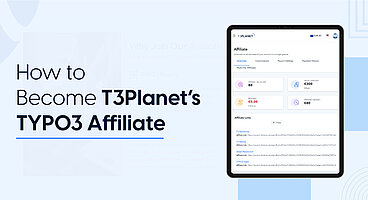Welcome to my TYPO3 feature release series blog for TYPO3 v13! In this blog, you will discover comprehensive details about significant features, noteworthy changes, and deprecations in TYPO3 v13.0. Keep reading!
I've chosen to compose the blog series covering the feature releases from TYPO3 v13.0 to v13.4, providing valuable insights for everyone in the TYPO3 community, from administrators and editors to developers and integrators. The official announcement lacks detailed information, prompting me to thoroughly examine each feature and breaking change, presenting them comprehensively here.
It's a moment of celebration as the TYPO3 v13 series kicks off with its first sprint release. TYPO3 version 13.0 signifies the inaugural stride towards the anticipated LTS release set for October 2024.
Before we start, I'd like to dedicate this blog to all the techies and non-techie TYPO3 contributors of TYPO3 who heartly worked to the release of TYPO3 v13.0. #T3Kudos
This release includes upgrades to the platform and dependencies, and it also achieves a significant milestone in the internationalization of the system. If you are interested in learning more about the planned other new features in TYPO3 version v13 is encouraged to read on.
In the usual manner of a dot-zero release, numerous libraries have undergone enhancements, establishing the foundation for forthcoming functionalities and enhancements in TYPO3 version 13.0's sprint releases.
Significant modifications have been introduced in the background, involving the elimination of outdated functions and components from TYPO3 v12 LTS, aligning with our deprecation policy.
TYPO3 has also defined updated minimum system prerequisites for v13, along with exciting features such as RTL support, custom backend URL, and WebP support, among others.
Let's delve into the principal alterations in this version. For more comprehensive technical details, refer to the v13 Changelog.
Before starting, Take a look at the major goals of TYPO3 v13 LTS (long-term support).
| Version | Primary Focus | Estimated Release |
| 13.0 | Breaking changes and new system requirements | Released: 2024-01-30 |
| 13.1 | Reusable components for creating new sites | Estimated: 2024-04-23 |
| 13.2 | Content blocks and new APIs for integrations | Estimated: 2024-07-02 |
| 13.3 | Feature freeze | Estimated: 2024-09-17 |
| 13.4 | LTS-release | Estimated: 2024-10-15 |
Source - TYPO3 CMS Development Roadmap
Official “Ocean Theme” of TYPO3 v13
Source image - TYPO3 v13 Roadmap Announcement
Secure TYPO3 with Configurable backend URL
$GLOBALS['TYPO3_CONF_VARS']['BE']['entryPoint'] = '/admin';Now point your browser to example.com/admin to log into the TYPO3 backend.
Configure to use a distinct (sub)domain
$GLOBALS['TYPO3_CONF_VARS']['BE']['entryPoint'] = 'https://backend.example.com';
$GLOBALS['TYPO3_CONF_VARS']['SYS']['cookieDomain'] = '.example.com';Now point your browser to backend.example.com/ to log into the TYPO3 Backend.
1. Elimination of Dedicated URI:
In TYPO3 version 13.0, the need for a dedicated URI like “/typo3/” has been eradicated. Previously, TYPO3 maintained separate entry points for frontend and backend areas with distinct URIs for HTTP requests.
Regardless of whether the requests are for the frontend or backend, all incoming requests to the system now share a single entry point.
2. Removal of "typo3/" Directory:
TYPO3 installations no longer require a “typo3/” directory for accessing the backend. This simplifies the structure and enhances flexibility.
3. Configurable Backend URI:
A configurable backend URI is introduced, addressing a long-standing feature request from the community. While the backend is still accessible through the default path “/typo3/”, administrators now have the ability to customize the backend URI based on their preferences.
Note: By default, the backend can still be accessed through the path “/typo3/”.
4. Adjustments for System Administrators:
System administrators need to make adjustments to the web server configuration to accommodate the consolidated entry points. This might involve modifying files like “.htaccess” for the Apache HTTP server.
Note: Consolidated entry points enhance configurability but necessitate some modifications in the web server configuration, reflecting TYPO3's commitment to adaptability and user customization.
Modern WebP Image Support
WebP, a contemporary image format designed for the web, offers numerous benefits over traditional PNG or JPEG files:
WebP images exhibit a file size reduction of approximately 30% compared to JPEG or PNG counterparts.
All current web browsers [https://caniuse.com/webp] support WebP, and it is compatible with most versions of ImageMagick/GraphicsMagick for processing and generation.
TYPO3 can generate WebP images provided that the underlying ImageMagick/GraphicsMagick library supports the WebP format.
By default, WebP images can now be generated, as TYPO3's configuration setting :
php:`$GLOBALS['TYPO3_CONF_VARS']['GFX']['imagefile_ext'] is now extended with "webp".
1. Accessibility for All Users:
TYPO3 has always aimed to make its user interface accessible to a diverse user base. Supporting over 60 backend languages by default has contributed to TYPO3's global user adoption.
2. Importance of Right-to-Left (RTL) Text Direction:
Beyond languages, accommodating different writing systems is crucial for localizable user interfaces. TYPO3 version 13.0 introduces support for RTL text direction in the backend.
3. Impact on Layout and Full Support:
The addition of RTL support influences the layout, affecting not only the content area but also tables, menus, and more, all of which are now fully supported.
4. Visual Showcase in Arabic:
Screenshots of the TYPO3 v13.0 backend in Arabic illustrate the comprehensive RTL support. Arabic, being one of the world's most widely used writing systems, is spoken by over 400 million people and is the official language in almost 30 countries.
5. Web Accessibility Beyond Language:
Emphasizing that web accessibility goes beyond language, Abdulhamid Kwieder highlights the importance of creating a digital space where users, regardless of reading from left-to-right or right-to-left, can feel at home.
6. Support for Various Languages:
RTL is not exclusive to Arabic; it's also used for languages like Hebrew, Kurdish (Sorani), Persian/Farsi, Urdu, Kashmiri, Pashto, and others.
7. Encouragement for Community Involvement:
TYPO3 encourages its community to contribute by translating backend labels into their respective languages. The Crowdin Tools are available to simplify the translation process, with support provided by the TYPO3 Localization Team.
1. Decoupling Admin Tools and Extension Manager:
In TYPO3 Version 13.0, two crucial backend modules, the Admin Tools (also known as the “Install Tool”) and the Extension Manager, have been separated from the TYPO3 Core.
2. Role of Admin Tools:
The Admin Tools handle the setup, configuration, and maintenance of the TYPO3 installation.
3. Functionality of Extension Manager:
The Extension Manager allows TYPO3 administrators and integrators to download, install, and uninstall extensions.
4. Reduced Dependency on Admin Tools and Extension Manager:
Due to the widespread adoption of Composer, many functions of the Admin Tools and Extension Manager are not mandatory. Specifically, these modules are not required in Composer-based installations.
5. Security Considerations:
Omitting the installation of Admin Tools and/or Extension Manager enhances security by reducing the potential attack surface. Without these modules, attackers cannot exploit low-level administrative functions that are not present.
6. Optional Removal:
While both modules have been decoupled from the TYPO3 Core, it's important to note that their removal is optional. The Admin Tools and Extension Manager continue to play a vital role in the TYPO3 ecosystem, providing essential functionalities for system management and extension handling.
7. Composer-Based Installations and Command-Line Functions:
With Composer-based installations, users can now execute these functions via the command line. This includes tasks such as installing TYPO3 Core, system configuration, and managing third-party extensions with automatic dependency management.
8. Custom Installation Choices:
System operators now have the flexibility to choose not to install these modules when setting up a new TYPO3 instance. Additionally, they can remove these components from existing installations by uninstalling the associated Composer packages (“typo3/cms-install” and “typo3/cms-extensionmanager”).
Finding the appropriate form definition for editing can pose a challenge for an editor, especially when dealing with numerous form definitions in the system. To simplify this process, the form manager now includes a search field. This feature facilitates a case-insensitive search based on either name or persistenceIdentifier. Users can now easily search for a specific form definition within the backend module of the form manager.
New Variable in Password Recovery Email
In the "felogin" extension of TYPO3's system, a functionality enables frontend users to initiate password resets.
Within the \TYPO3\CMS\Core\Mail\FluidEmail object for password recovery, a fresh array variable named userData is introduced. This variable encompasses the values of all fields associated with the respective frontend user.
Utilizing the {userData} variable in the Fluid template for password recovery now enables the retrieval of data from the frontend user undergoing the password reset process.
In TYPO3 Version 13, developers have the ability to create their own keyboard shortcuts for the backend. For example, backend users can now open the LiveSearch by pressing Ctrl/Cmd + K or save the currently opened document with Ctrl/Cmd + S.
TYPO3 provides the @typo3/backend/hotkeys.js module that allows developers to register custom keyboard shortcuts in the TYPO3 backend.
import { Hotkeys, ModifierKeys } from '@typo3/backend/hotkeys.js';
Hotkeys.register(
[Hotkeys.normalizedCtrlModifierKey, ModifierKeys.ALT, 'e'],
function (keyboardEvent) => {
console.log('Triggered on Ctrl/Cmd+Alt+E');
},
{
scope: 'my-extension/module',
bindElement: document.querySelector('.some-element')
}
);
// Get the currently active scope
const currentScope = Hotkeys.getScope();
// Make use of registered scope
Hotkeys.setScope('my-extension/module');A new "Edit Metadata" button has been introduced in the file element information view, enabling direct editing of associated Metadata without exiting the current context. Access to the element information view for files can be obtained through the context menu or the secondary action of files in any file listing, such as in the File > Filelist module or the File selector. This enhancement allows for the direct editing of a file's Metadata within the element information view, enhancing the user experience by maintaining context.
Show if redirects were checked in report
In the status report is an entry to show, if redirect conflicts have been found. However, there was previously no indication if / when the last check was run. If there were no conflicts, a status of "ok" was reported which could be quite misleading, if a redirect check was not performed lately.
Allow configuration of color palettes in FormEngine
TYPO3 uses a color picker component that already supports color palettes, or swatches. Integrators are now able to configure colors and assign colors to palettes. Palettes then may be used within FormEngine.
EXT:my_sitepackage/Configuration/page.tsconfig
# Configure colors and assign colors to palettes
colorPalettes {
colors {
typo3 {
value = #ff8700
}
blue {
value = #0080c9
}
darkgray {
value = #515151
}
valid {
value = #5abc55
}
error {
value = #dd123d
}
}
palettes {
main = typo3
key_colors = typo3, blue, darkgray
messages = valid, error
}
}
# Assign palette to a specific field
TCEFORM.[table].[field].colorPalette = messages
# Assign palette to all color pickers used in a table
TCEFORM.[table].colorPalette = key_colors
# Assign global palette
TCEFORM.colorPalette = mainMake autocomplete selectable in EXT:form backend
Autocomplete options can already be added to input fields in EXT:form via editing the YAML. This was hard or impossible to do for editors. Editors can now select the autocomplete input purpose when editing forms.
FAL support for FlexFormProcessor
The FlexFormProcessor is now able to resolve FAL references by its own. Each FlexForm field, which should be resolved, needs a reference definition to the foreign_match_fields. This reference is later used in the FilesProcessor to resolve the correct FAL resource.
10 = TYPO3\CMS\Frontend\DataProcessing\FlexFormProcessor
10 {
fieldName = my_flexform_field
references {
my_flex_form_group.my_flex_form_field = my_field_reference
}
as = myOutputVariable
}What Are Deprecation in TYPO3 v13?
TYPO3 is known for its outstanding stability, resilience, and trustworthiness as an enterprise content management system. These attributes are maintained through adherence to a rigorous deprecation policy and a commitment to backward compatibility. This piece offers valuable insights for integrators and developers, shedding light on the considerations for TYPO3 upgrades and when they are unequivocally advantageous.
TYPO3 also eliminated functions and components identified as deprecated in TYPO3 version 12 LTS according to the deprecation policy and established fresh minimum system prerequisites for version 13.
Important Breaking Changes in TYPO3 v13
TYPO3 has initiated a purification procedure, eliminating obsolete or legacy components like deprecated PHP classes, functions, and CLI calls. This cleanup mainly targets developers and adheres to the standard practice for dot-zero releases.
Here, I want to share some important breaking changes from TYPO3 v13.
Removed PHP Classes
Numerous PHP classes, previously flagged as deprecated in v12, have been eliminated.
Remove jquery-ui
The NPM package jquery-ui has been entirely eliminated for TYPO3 v13 with no alternative. As per the TYPO3 Deprecation Policy, JavaScript code and packages exclusively employed in the TYPO3 backend are exempt from the said policy.
Page Doktype "Recycler" removed
We optimized the backend representation of the recycler/trash bin concept, eliminating the long-standing TYPO3 function known as the recycler page type. Page entries designated with "doktype=255" indicated a recycler bin. The Recycler backend module now provides equivalent functionality, with enhanced user-friendliness, safety, and additional features.
Remove RequireJS
The RequireJS project has been deprecated in TYPO3 v12 in favor of native ECMAScript v6/v11 modules. The infrastructure for configuring and loading RequireJS modules has been eliminated
Remove bootstrap jQuery interface and window.jQuery
The bootstrap jQuery interfaces necessitated the establishment of a global window.jQuery variable. The jquery drop-in has been eliminated to eliminate this mandatory reliance on jQuery.
EXT:t3editor merged into EXT:backend
TYPO3 has long included a code editor extension known as "t3editor." Historically, this extension was offered as an option. Upon installation of the extension, designated text areas are transformed into code editors utilizing CodeMirror. Now, the once-optional extension has been integrated into EXT:backend, ensuring the constant availability of the code editor.
TSFE->fe_user removed
The TypoScriptFrontendController->fe_user property related to the frontend has been eliminated.
What are the System Requirements in TYPO3 v13?
| PHP versions | TYPO3 v13 (2023-2027) | TYPO3 v12 (2021-2026) | TYPO3 v11 (2020-2024) | TYPO3 v10 (2019-2023) | TYPO3 v9 (2017-2021) | TYPO3 v8 (2015-2020) |
| PHP 7.0 | No | No | No | No | No | Yes |
| PHP 7.1 | No | No | No | No | No | Yes |
| PHP 7.2 | No | No | No | Yes | Yes | Yes |
| PHP 7.3 | No | No | No | Yes | Yes | Yes |
| PHP 7.4 | No | No | Yes | Yes | Yes | Yes |
| PHP 8.0 | No | No | Yes | No | No | No |
| PHP 8.1 | No | Yes | Yes | No | No | No |
| PHP 8.2 | Yes | Yes | Yes | No | No | No |
| PHP 8.3 | Yes | Yes | Yes | No | No | No |
In TYPO3 version 13.0, there are new minimum system requirements, setting the stage for planned enhancements in upcoming sprint releases and ensuring compatibility with modern dependent packages with long-term support.
PHP Version Requirement:
TYPO3 now requires PHP version 8.2. This version will receive security updates until December 2025. It is also a prerequisite for Symfony version 7, another key component of TYPO3 v13. Symfony v7 is slated for support until November 2028.
Doctrine Database Abstraction Layer (DBAL) Update:
There are plans to update Doctrine, the DBAL used in TYPO3. Doctrine DBAL v4 is in its first release candidate stage, with the final release expected in the coming months. Developers can find more information about breaking changes in Doctrine DBAL v4 in the upgrade notes.
Impact on Supported Database Engines:
The upgrade to Doctrine v4 influences the system requirements for supported database engines. TYPO3 v13.x supports the following database products and versions:
- MySQL version 8.0.17 or higher
- MariaDB version 10.4.3 or higher
- PostgreSQL version 10.0 or higher
- SQLite version 3.8.3 or higher
Upgrade Process Hint:
When upgrading from TYPO3 v12 LTS to TYPO3 v13.x, it is recommended to update the platform first, followed by the TYPO3 instance. TYPO3 v12 LTS supports PHP version 8.2 and the MariaDB and MySQL database engine versions also supported by TYPO3 v13.x.
image source - TYPO3 CMS Development Roadmap
Support Timeline:
Each TYPO3 sprint release (v13.0 to v13.3) will be supported until the next minor version is released. TYPO3 v13 LTS (version 13.4), the long-term support version, will receive bug fixes until April 30, 2026. Security patches for TYPO3 v13 LTS will be provided until October 31, 2027.
Further Details:
Additional information about requirements and dependencies can be found on get.typo3.org. These measures ensure that TYPO3 remains up-to-date, secure, and well-supported for users and developers alike.
Give A Try - Download & Install v13.0
For comprehensive details on the release, including how to download and install TYPO3, visit get.typo3.org. The Installation Guide provides in-depth instructions for the installation process.
We strongly recommend utilizing Composer to establish your TYPO3 environment, ensuring a streamlined and efficient setup. Follow the provided resources to make the installation process smooth and successful.
Seeking TYPO3 Upgrade Partner?
Upgrade your TYPO3 website effortlessly with T3Planet! We specialize in making your TYPO3 experience seamless and easy. Integrators, administrators, developers, and – there's something for everyone in our TYPO3 v12 blog! Click here to have more about TYPO3 v12 LTS.
Wrap-up! What can you do for TYPO3?
In conclusion, TYPO3 version 13.0 is a testament to innovation, adaptability, and progress. The release not only brings forth a range of exciting features but also represents a commitment to keeping TYPO3 at the forefront of technology.
From the enhanced internationalization with RTL support to the decoupling of backend modules and the streamlined backend entry point, every aspect is designed to elevate user experience and developer efficiency.
The journey doesn't end here; it's an invitation to the TYPO3 community and beyond to explore, contribute, and continue shaping the future of TYPO3. The details provided here are sourced from the official documentation. Grateful to the wonderful TYPO3 Community.
Finally, I'd like to express two sentiments:
Write Thanks Notes
Show Appreciation Express gratitude through thank-you notes for their valuable contributions to the TYPO3 OpenSource community. Share your appreciation on social media, in the Slack group, or consider Donate to TYPO3.
Keep Exploring & Learning
Install and set up TYPO3 v13, learn independently (like prepared for the change of your project or extension), and if you encounter any issues or have suggestions, Submit a ticket on TYPO3 Forge.
Have a Happy TYPO3 Release!






















Sanjay Chauhan
CTO at T3Planet & NITSANSanjay Chauhan, Co-Founder of NITSAN (Award winning TYPO3 agency) and Pioneer of T3Planet (first-ever TYPO3 Store).
A true TYPO3 fanatic since 2010. I bring strong TYPO3 experience in building customer-business…
More From Author